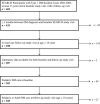Transition from pediatric to adult care for youth diagnosed with type 1 diabetes in adolescence
- PMID: 23530167
- PMCID: PMC4535025
- DOI: 10.1542/peds.2012-1450
Transition from pediatric to adult care for youth diagnosed with type 1 diabetes in adolescence
Abstract
Objective: Youth with type 1 diabetes mellitus are at risk for poor glycemic control as they age into adulthood. The aim of this study was to describe sociodemographic and clinical correlates of poor glycemic control associated with the transfer of care from pediatric to adult diabetes providers among a cohort of youth with type 1 diabetes diagnosed in adolescence.
Methods: Analyses included 185 adolescent participants with recently diagnosed type 1 diabetes in the SEARCH for Diabetes in Youth Study with pediatric care at baseline who were age ≥18 years at follow-up. Demographic and clinical factors were measured by survey and laboratory results. Survival analysis was used to estimate the age of transition. Logistic regression analysis assessed the association of demographic and clinical factors with the transition of care and poor glycemic control at follow-up.
Results: Fifty-seven percent of participants had transitioned to adult diabetes care providers by the follow-up visit. The estimated median age of transition of care was 20.1 years (95% confidence interval 19.8-20.4). Older age, lower baseline glycosylated hemoglobin, and less parental education were independently associated with increased odds of transition. The odds of poor glycemic control at follow-up were 2.5 times higher for participants who transitioned to adult care compared with those who remained in pediatric care.
Conclusions: Transferring from pediatric to adult care, experienced by more than half the sample, was associated with an increased risk of poor glycemic control at follow-up. These findings suggest that young adults need additional support when moving to adult care.
Figures
References
-
- Busse FP, Hiermann P, Galler A, et al. . Evaluation of patients’ opinion and metabolic control after transfer of young adults with type 1 diabetes from a pediatric diabetes clinic to adult care. Horm Res. 2007;67(3):132–138 - PubMed
-
- Nakhla M, Daneman D, To T, Paradis G, Guttmann A. Transition to adult care for youths with diabetes mellitus: findings from a Universal Health Care System. Pediatrics. 2009;124(6). Available at: www.pediatrics.org/cgi/content/full/124/6/e1134. - PubMed
-
- Peters A, Laffel L, American Diabetes Association Transitions Working Group . Diabetes care for emerging adults: recommendations for transition from pediatric to adult diabetes care systems: a position statement of the American Diabetes Association, with representation by the American College of Osteopathic Family Physicians, the American Academy of Pediatrics, the American Association of Clinical Endocrinologists, the American Osteopathic Association, the Centers for Disease Control and Prevention, Children with Diabetes, The Endocrine Society, the International Society for Pediatric and Adolescent Diabetes, Juvenile Diabetes Research Foundation International, the National Diabetes Education Program, and the Pediatric Endocrine Society (formerly Lawson Wilkins Pediatric Endocrine Society).. Diabetes Care. 2011;34(11):2477–2485 - PMC - PubMed
-
- Bowen M, Henske J, Potter A. Health care transition in adolescents and young adults with diabetes. Clin Diabetes. 2010;28(3):99–106
Publication types
MeSH terms
Substances
Grants and funding
- U01 DP000247/DP/NCCDPHP CDC HHS/United States
- U01 DP000245/DP/NCCDPHP CDC HHS/United States
- U48/CCU419249/PHS HHS/United States
- M01 RR000069/RR/NCRR NIH HHS/United States
- U18 DP002714/DP/NCCDPHP CDC HHS/United States
- U01 DP000248/DP/NCCDPHP CDC HHS/United States
- P30 DK57516/DK/NIDDK NIH HHS/United States
- U48/CCU519239/PHS HHS/United States
- U18DP002710-01/DP/NCCDPHP CDC HHS/United States
- K23 DK089017/DK/NIDDK NIH HHS/United States
- CC999999/ImCDC/Intramural CDC HHS/United States
- U01 DP000250/DP/NCCDPHP CDC HHS/United States
- HIR 10-001/HX/HSRD VA/United States
- P30 DK057516/DK/NIDDK NIH HHS/United States
- U58 CCU019235-4/PHS HHS/United States
- 1U18DP002709/DP/NCCDPHP CDC HHS/United States
- U48/CCU819241-3/PHS HHS/United States
- M01RR00037/RR/NCRR NIH HHS/United States
- U18 DP002710/DP/NCCDPHP CDC HHS/United States
- U18DP002714/DP/NCCDPHP CDC HHS/United States
- U18DP002708-01/DP/NCCDPHP CDC HHS/United States
- 200-2010-35171/PHS HHS/United States
- U48/CCU919219/PHS HHS/United States
- M01 RR000037/RR/NCRR NIH HHS/United States
- PA DP-10-001/DP/NCCDPHP CDC HHS/United States
- U01 DP000244/DP/NCCDPHP CDC HHS/United States
- PA 00097/PHS HHS/United States
- U58CCU919256/PHS HHS/United States
- 1UL1RR026314-01/RR/NCRR NIH HHS/United States
- U18DP000247-06A1/DP/NCCDPHP CDC HHS/United States
- U01DP000247/DP/NCCDPHP CDC HHS/United States
- UL1 RR029882/RR/NCRR NIH HHS/United States
- M01 RR00069/RR/NCRR NIH HHS/United States
- PA DP-05-069/DP/NCCDPHP CDC HHS/United States
- U18 DP002709/DP/NCCDPHP CDC HHS/United States
- ImNIH/Intramural NIH HHS/United States
- U01 DP000246/DP/NCCDPHP CDC HHS/United States
- U01 DP000254/DP/NCCDPHP CDC HHS/United States
- UL1 RR026314/RR/NCRR NIH HHS/United States
- U18 DP002708/DP/NCCDPHP CDC HHS/United States
- UL1RR029882/RR/NCRR NIH HHS/United States
LinkOut - more resources
Full Text Sources
Other Literature Sources
Medical


